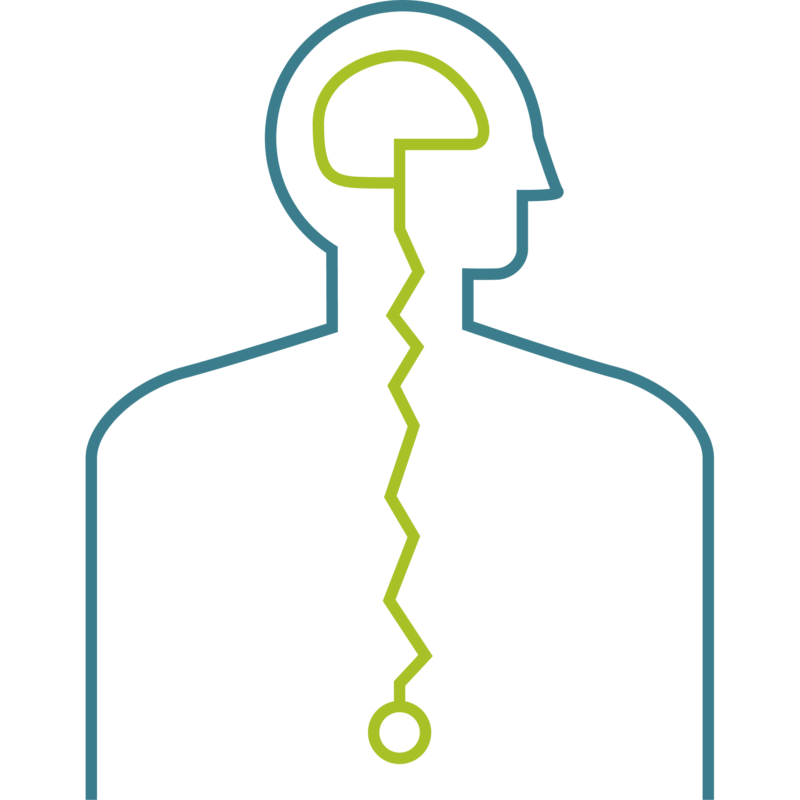Signs and Symptoms of Severe Spasticity
What is Severe Spasticity?
Spasticity is a velocity-dependent increase in tone (resistance to passive range of motion) associated with upper motor neuron lesions. Spasticity is usually caused by damage to the portion of the brain or spinal cord that controls voluntary movement.³
Conditions that may lead to severe spasticity include:
Spasticity treatment options may include use of baclofen, a muscle relaxant. Baclofen may be taken either orally or by injection. In cases of severe spasticity, the intrathecal baclofen (ITB) pump may be an option. If your spasticity is caused by traumatic brain injury, wait at least one year after injury before asking your doctor to consider ITB therapy.4
Why Treat Severe Spasticity?
Severe Spasticity is More Than Just a Symptom
- It leads to frustration with activities of daily living.
- It means difficulty with positioning, walking, mobilizing a wheelchair, transferring to and from a bed or car.
- It can be the difference between independent living or life with a caregiver.
Other side effects include, but are not limited to:
When Left Untreated4
Frozen or immobilized joints, known as contractures
Pressure sores
Other triggers that can set off a dangerous escalation of symptoms
Adverse Effects4
Muscle stiffness and spasms
Involuntary crossing of the legs
Muscle fatigue and muscle and joint deformities
Inhibition of longitudinal muscle growth and protein synthesis in muscle cells
Additional Complications4
Urinary tract infections
Chronic constipation
Fever or other systemic illnesses
Spasticity Management Options
Currently, there is no cure for spasticity, but there are options that can help you manage your symptoms.

Rehabilitation Therapy
Physical, occupational or speech therapy may help manage symptoms. Patients can receive rehabilitation therapy alone or along with other treatments.

Medicine
Severe spasticity can be managed using oral medications or ITB Therapy (intrathecal baclofen therapy).
Intrathecal baclofen therapy (ITB) is an established and widely accepted treatment option for severe spasticity. More than 60,000 baclofen pumps have been implanted worldwide since 1992. Studies show that ITB Therapy reduces spasticity and spasms.4
How ITB Works
In severe cases of spasticity, baclofen can be administered through a pump that has been surgically implanted in your abdomen.4
The sealed ITB pump has a chamber. It holds enough liquid baclofen to give up to 180 days of treatment for some patients. The pump is programmed to give medicine all the time, and your healthcare provider can adjust the amount of baclofen delivered.4
Why Pump Therapy Is Different
Baclofen taken orally must move through the digestive system before reaching a certain point in the central nervous system. An ITB pump sends the medicine right to the fluid around the spine. Because of this, it works at a lower dose than oral baclofen.4
Oral baclofen may need to be taken as often as 3 to 4 times a day. An intrathecal baclofen pump is a personalized, programmable pump to release medicine all the time, so you don’t need to think about taking it.4

Surgery
Surgeries are available to improve function of tendons, muscles and/or bones. Surgery on the nerves that go into the spinal cord may also be an option.
Real Patient, Real Relief

Spasticity Treatment Brought Comfort Back to Lynn’s Life
A stroke left Lynn suffering from severe spastic right hemiplegia and confined to a wheelchair. While oral tizanidine and routine botulinum toxin injections mildly reduced her spasticity, dosing limitations prevented Lynn from getting an optimal treatment level. The less-than-ideal relief presented problems in operating her power wheelchair. When navigating over uneven surfaces, her right ankle clonus would trigger, the wheelchair would jerk, her leg would spasm into extension and ultimately Lynn would fall out of her chair. Wanting to be free from the frustration of falling and wanting more relief from her severe spasticity, Lynn underwent a trial of Intrathecal Baclofen (ITB) therapy at her doctor’s suggestion. The trial proved to significantly reduce Lynn’s right lower extremity spasticity. She underwent the pump implantation and after dose optimization, her right ankle clonus completely resolved. The combination of ITB and botulinum toxin injections provides Lynn with the optimal treatment she so desperately wanted and brings her comfort in navigating around as she doesn’t fear her leg will spasm and she’ll fall.
See how intrathecal baclofen therapy with Gablofen is helping Lynn and others find relief.
Have a Specific Question?
Important Risk Information
INDICATIONS AND USAGE
- Gablofen® (baclofen injection) is a gamma-aminobutyric acid (GABA) ergic agonist indicated for use in the management of severe spasticity of cerebral or spinal origin in adult and pediatric patients age 4 years and above.
- Gablofen should be reserved for patients unresponsive to oral baclofen therapy, or those who experience intolerable central nervous system side effects at effective doses.
- Patients should first respond to a screening dose of intrathecal baclofen prior to consideration for long term infusion via an implantable pump.
- Spasticity due to traumatic brain injury: wait at least one year after injury before considering Gablofen therapy.
IMPORTANT RISK INFORMATION
WARNING: DO NOT DISCONTINUE ABRUPTLY
See full prescribing information for complete boxed warning
Abrupt discontinuation of intrathecal baclofen, regardless of the cause, has resulted in sequelae that include high fever, altered mental status, exaggerated rebound spasticity, and muscle rigidity, that in rare cases has advanced to rhabdomyolysis, multiple organ-system failure and death.
Prevention of abrupt discontinuation of intrathecal baclofen requires careful attention to programming and monitoring of the infusion system, refill scheduling and procedures, and pump alarms. Patients and caregivers should be advised of the importance of keeping scheduled refill visits and should be educated on the early symptoms of baclofen withdrawal. Special attention should be given to patients at apparent risk (e.g. spinal cord injuries at T-6 or above, communication difficulties, history of withdrawal symptoms from oral or intrathecal baclofen). Consult the technical manual of the implantable infusion system for additional post-implant clinician and patient information.
CONTRAINDICATIONS
- Hypersensitivity to baclofen.
- Do not use Gablofen for intravenous, intramuscular, subcutaneous or epidural administration.
WARNINGS AND PRECAUTIONS
- Risk of life-threatening overdose during pump refills. Use extreme caution when filling the Medtronic SynchroMed® II Programmable Pump which is equipped with an injection port that allows direct access to the intrathecal catheter. Direct injection into the catheter through the catheter access port may cause a life-threatening overdose.
- Use only with Medtronic SynchroMed II Programmable Pump (or other pumps labeled for intrathecal administration of Gablofen (baclofen injection)).
- Potential for contamination due to non-sterile external surface of prefilled syringe. Although the drug solution and pathway in the Gablofen prefilled syringes are sterile, the external surface of the prefilled syringes (all strengths, including the 50 mcg/mL strength) are non-sterile and have the potential to lead to contamination and consequent adverse reactions. The use of Gablofen prefilled syringe in an aseptic setting (e.g., operating room) to fill sterile intrathecal pumps prior to implantation in patients is not recommended, unless the external surface of the prefilled syringe is treated to ensure sterility. Gablofen supplied in vials may be used with conventional aseptic technique to fill intrathecal pumps prior to implantation.
- Resuscitative equipment and trained staff must be available during screening dose, dose titration, and refills due to the potential life-threatening CNS depression, cardiovascular collapse, and/or respiratory failure.
- Overdose may cause drowsiness, lightheadedness, dizziness, somnolence, respiratory depression, seizures, rostral progression of hypotonia and loss of consciousness progressing to coma.
- Use with caution in patients with psychotic disorders, schizophrenia or confusional states as it may exacerbate condition(s).
- Fatalities have been reported with intrathecal baclofen use.
- Caution should be used in patients with a history of autonomic dysreflexia.
- Presence of infection may increase the risk of surgical complication and complicate dosing of Gablofen.
- May cause drowsiness: use caution in operation of automobiles, dangerous machinery and activity that may be hazardous by decreased alertness. Other CNS depressants and alcohol may add to this effect.
- Potential development of intrathecal mass formation. Clinicians should monitor for signs and symptoms of new neurologic symptoms including the use of imaging diagnostic modalities.
- Oral baclofen use has been associated with a dose-related increase in incidence of ovarian cysts.
ADVERSE REACTIONS
- Serious Adverse Reactions
- Sudden withdrawal of Gablofen can result in serious complications that include high fever, confusion, muscle stiffness, multiple organ-system failure, and death. Inform patients that early symptoms of Gablofen withdrawal may include increased spasticity, itching, and tingling of extremities. If Gablofen withdrawal or a pump malfunction is suspected, patients should be brought immediately to a hospital for assessment and treatment.
- Gablofen overdose may occur suddenly or insidiously, and symptoms may include confusion, drowsiness, lightheadedness, dizziness, slow or shallow breathing, seizures, loss of muscle tone, loss of consciousness, and coma.
- Other serious adverse events may include: potential development of intrathecal mass formation, drainage, infection, meningitis, unmanageable trunk control, CSF leakage, coma and death.
- Common Adverse Reactions
- The most common adverse reactions in patients with spasticity of spinal origin were hypotonia (25.3%), somnolence (20.9%), dizziness, nausea/vomiting, hypotension, headache, and convulsions.
- The most common adverse reactions in patients with spasticity of cerebral origin were hypotonia (34.7%), somnolence (18.7%), headache (10.7%), agitation, constipation, leukocytosis, chills, and urinary retention.
- Other common adverse events may include hypoventilation, hypertonia, paresthesia, increased salivation, back pain, pruritus, diarrhea, peripheral edema, asthenia, pain, confusion, speech disorder, amblyopia, accidental injury, and dry mouth.
USE IN SPECIFIC POPULATIONS
- Pregnancy Category C. The effect of baclofen in labor and delivery is unknown.
- Breastfeeding: Baclofen is excreted into breast milk at oral therapeutic doses.
- Pediatric use: Safety and effectiveness in pediatric patients below the age of 4 years have not been established.
INDICATIONS AND USAGE
- Gablofen® (baclofen injection) is a gamma-aminobutyric acid (GABA) ergic agonist indicated for use in the management of severe spasticity of cerebral or spinal origin in adult and pediatric patients age 4 years and above.
- Gablofen should be reserved for patients unresponsive to oral baclofen therapy, or those who experience intolerable central nervous system side effects at effective doses.
- Patients should first respond to a screening dose of intrathecal baclofen prior to consideration for long term infusion via an implantable pump.
- Spasticity due to traumatic brain injury: wait at least one year after injury before considering Gablofen therapy.
IMPORTANT RISK INFORMATION
WARNING: DO NOT DISCONTINUE ABRUPTLY
See full prescribing information for complete boxed warning
Abrupt discontinuation of intrathecal baclofen, regardless of the cause, has resulted in sequelae that include high fever, altered mental status, exaggerated rebound spasticity, and muscle rigidity, that in rare cases has advanced to rhabdomyolysis, multiple organ-system failure and death.
Prevention of abrupt discontinuation of intrathecal baclofen requires careful attention to programming and monitoring of the infusion system, refill scheduling and procedures, and pump alarms. Patients and caregivers should be advised of the importance of keeping scheduled refill visits and should be educated on the early symptoms of baclofen withdrawal. Special attention should be given to patients at apparent risk (e.g. spinal cord injuries at T-6 or above, communication difficulties, history of withdrawal symptoms from oral or intrathecal baclofen). Consult the technical manual of the implantable infusion system for additional post-implant clinician and patient information.
CONTRAINDICATIONS
- Hypersensitivity to baclofen.
- Do not use Gablofen for intravenous, intramuscular, subcutaneous or epidural administration.
WARNINGS AND PRECAUTIONS
- Risk of life-threatening overdose during pump refills. Use extreme caution when filling the Medtronic SynchroMed® II Programmable Pump which is equipped with an injection port that allows direct access to the intrathecal catheter. Direct injection into the catheter through the catheter access port may cause a life-threatening overdose.
- Use only with Medtronic SynchroMed II Programmable Pump (or other pumps labeled for intrathecal administration of Gablofen (baclofen injection)).
- Potential for contamination due to non-sterile external surface of prefilled syringe. Although the drug solution and pathway in the Gablofen prefilled syringes are sterile, the external surface of the prefilled syringes (all strengths, including the 50 mcg/mL strength) are non-sterile and have the potential to lead to contamination and consequent adverse reactions. The use of Gablofen prefilled syringe in an aseptic setting (e.g., operating room) to fill sterile intrathecal pumps prior to implantation in patients is not recommended, unless the external surface of the prefilled syringe is treated to ensure sterility. Gablofen supplied in vials may be used with conventional aseptic technique to fill intrathecal pumps prior to implantation.
- Resuscitative equipment and trained staff must be available during screening dose, dose titration, and refills due to the potential life-threatening CNS depression, cardiovascular collapse, and/or respiratory failure.
- Overdose may cause drowsiness, lightheadedness, dizziness, somnolence, respiratory depression, seizures, rostral progression of hypotonia and loss of consciousness progressing to coma.
- Use with caution in patients with psychotic disorders, schizophrenia or confusional states as it may exacerbate condition(s).
- Fatalities have been reported with intrathecal baclofen use.
- Caution should be used in patients with a history of autonomic dysreflexia.
- Presence of infection may increase the risk of surgical complication and complicate dosing of Gablofen.
- May cause drowsiness: use caution in operation of automobiles, dangerous machinery and activity that may be hazardous by decreased alertness. Other CNS depressants and alcohol may add to this effect.
- Potential development of intrathecal mass formation. Clinicians should monitor for signs and symptoms of new neurologic symptoms including the use of imaging diagnostic modalities.
- Oral baclofen use has been associated with a dose-related increase in incidence of ovarian cysts.
ADVERSE REACTIONS
- Serious Adverse Reactions
- Sudden withdrawal of Gablofen can result in serious complications that include high fever, confusion, muscle stiffness, multiple organ-system failure, and death. Inform patients that early symptoms of Gablofen withdrawal may include increased spasticity, itching, and tingling of extremities. If Gablofen withdrawal or a pump malfunction is suspected, patients should be brought immediately to a hospital for assessment and treatment.
- Gablofen overdose may occur suddenly or insidiously, and symptoms may include confusion, drowsiness, lightheadedness, dizziness, slow or shallow breathing, seizures, loss of muscle tone, loss of consciousness, and coma.
- Other serious adverse events may include: potential development of intrathecal mass formation, drainage, infection, meningitis, unmanageable trunk control, CSF leakage, coma and death.
- Common Adverse Reactions
- The most common adverse reactions in patients with spasticity of spinal origin were hypotonia (25.3%), somnolence (20.9%), dizziness, nausea/vomiting, hypotension, headache, and convulsions.
- The most common adverse reactions in patients with spasticity of cerebral origin were hypotonia (34.7%), somnolence (18.7%), headache (10.7%), agitation, constipation, leukocytosis, chills, and urinary retention.
- Other common adverse events may include hypoventilation, hypertonia, paresthesia, increased salivation, back pain, pruritus, diarrhea, peripheral edema, asthenia, pain, confusion, speech disorder, amblyopia, accidental injury, and dry mouth.
USE IN SPECIFIC POPULATIONS
- Pregnancy Category C. The effect of baclofen in labor and delivery is unknown.
- Breastfeeding: Baclofen is excreted into breast milk at oral therapeutic doses.
- Pediatric use: Safety and effectiveness in pediatric patients below the age of 4 years have not been established.
Important Risk Information
INDICATIONS AND USAGE
- Gablofen® (baclofen injection) is a gamma-aminobutyric acid (GABA) ergic agonist indicated for use in the management of severe spasticity of cerebral or spinal origin in adult and pediatric patients age 4 years and above.
- Gablofen should be reserved for patients unresponsive to oral baclofen therapy, or those who experience intolerable central nervous system side effects at effective doses.
- Patients should first respond to a screening dose of intrathecal baclofen prior to consideration for long term infusion via an implantable pump.
- Spasticity due to traumatic brain injury: wait at least one year after injury before considering Gablofen therapy.
IMPORTANT RISK INFORMATION
WARNING: DO NOT DISCONTINUE ABRUPTLY
See full prescribing information for complete boxed warning
Abrupt discontinuation of intrathecal baclofen, regardless of the cause, has resulted in sequelae that include high fever, altered mental status, exaggerated rebound spasticity, and muscle rigidity, that in rare cases has advanced to rhabdomyolysis, multiple organ-system failure and death.
Prevention of abrupt discontinuation of intrathecal baclofen requires careful attention to programming and monitoring of the infusion system, refill scheduling and procedures, and pump alarms. Patients and caregivers should be advised of the importance of keeping scheduled refill visits and should be educated on the early symptoms of baclofen withdrawal. Special attention should be given to patients at apparent risk (e.g. spinal cord injuries at T-6 or above, communication difficulties, history of withdrawal symptoms from oral or intrathecal baclofen). Consult the technical manual of the implantable infusion system for additional post-implant clinician and patient information.
CONTRAINDICATIONS
Hypersensitivity to baclofen.
Do not use Gablofen for intravenous, intramuscular, subcutaneous or epidural administration.
WARNINGS AND PRECAUTIONS
Risk of life-threatening overdose during pump refills. Use extreme caution when filling the Medtronic SynchroMed® II Programmable Pump which is equipped with an injection port that allows direct access to the intrathecal catheter. Direct injection into the catheter through the catheter access port may cause a life-threatening overdose.
Use only with Medtronic SynchroMed® II Programmable Pump (or other pumps labeled for intrathecal administration of Gablofen (baclofen injection)).
Potential for contamination due to non-sterile external surface of prefilled syringe. Although the drug solution and pathway in the Gablofen prefilled syringes are sterile, the external surface of the prefilled syringes (all strengths, including the 50 mcg/mL strength) are non-sterile and have the potential to lead to contamination and consequent adverse reactions. The use of Gablofen prefilled syringe in an aseptic setting (e.g., operating room) to fill sterile intrathecal pumps prior to implantation in patients is not recommended, unless the external surface of the prefilled syringe is treated to ensure sterility. Gablofen supplied in vials may be used with conventional aseptic technique to fill intrathecal pumps prior to implantation.
Resuscitative equipment and trained staff must be available during screening dose, dose titration, and refills due to the potential life-threatening CNS depression, cardiovascular collapse, and/or respiratory failure.
Overdose may cause drowsiness, lightheadedness, dizziness, somnolence, respiratory depression, seizures, rostral progression of hypotonia and loss of consciousness progressing to coma.
Use with caution in patients with psychotic disorders, schizophrenia or confusional states as it may exacerbate condition(s).
Fatalities have been reported with intrathecal baclofen use.
Caution should be used in patients with a history of autonomic dysreflexia.
Presence of infection may increase the risk of surgical complication and complicate dosing of Gablofen.
May cause drowsiness: use caution in operation of automobiles, dangerous machinery and activity that may be hazardous by decreased alertness. Other CNS depressants and alcohol may add to this effect.
Potential development of intrathecal mass formation. Clinicians should monitor for signs and symptoms of new neurologic symptoms including the use of imaging diagnostic modalities.
Oral baclofen use has been associated with a dose-related increase in incidence of ovarian cysts.
ADVERSE REACTIONS
Serious Adverse Reactions
- Sudden withdrawal of Gablofen can result in serious complications that include high fever, confusion, muscle stiffness, multiple organ-system failure, and death. Inform patients that early symptoms of Gablofen withdrawal may include increased spasticity, itching, and tingling of extremities. If Gablofen withdrawal or a pump malfunction is suspected, patients should be brought immediately to a hospital for assessment and treatment.
- Gablofen overdose may occur suddenly or insidiously, and symptoms may include confusion, drowsiness, lightheadedness, dizziness, slow or shallow breathing, seizures, loss of muscle tone, loss of consciousness, and coma.
- Other serious adverse events may include: potential development of intrathecal mass formation, drainage, infection, meningitis, unmanageable trunk control, CSF leakage, coma and death.
Common Adverse Reactions
- The most common adverse reactions in patients with spasticity of spinal origin were hypotonia (25.3%), somnolence (20.9%), dizziness, nausea/vomiting, hypotension, headache, and convulsions.
- The most common adverse reactions in patients with spasticity of cerebral origin were hypotonia (34.7%), somnolence (18.7%), headache (10.7%), agitation, constipation, leukocytosis, chills, and urinary retention.
- Other common adverse events may include hypoventilation, hypertonia, paresthesia, increased salivation, back pain, pruritus, diarrhea, peripheral edema, asthenia, pain, confusion, speech disorder, amblyopia, accidental injury, and dry mouth.
USE IN SPECIFIC POPULATIONS
Pregnancy Category C. The effect of baclofen in labor and delivery is unknown.
Breastfeeding: Baclofen is excreted into breast milk at oral therapeutic doses.
Pediatric use: Safety and effectiveness in pediatric patients below the age of 4 years have not been established.
INDICATIONS AND USAGE
- Gablofen® (baclofen injection) is a gamma-aminobutyric acid (GABA) ergic agonist indicated for use in the management of severe spasticity of cerebral or spinal origin in adult and pediatric patients age 4 years and above.
- Gablofen should be reserved for patients unresponsive to oral baclofen therapy, or those who experience intolerable central nervous system side effects at effective doses.
- Patients should first respond to a screening dose of intrathecal baclofen prior to consideration for long term infusion via an implantable pump.
- Spasticity due to traumatic brain injury: wait at least one year after injury before considering Gablofen therapy.
IMPORTANT RISK INFORMATION
WARNING: DO NOT DISCONTINUE ABRUPTLY
See full prescribing information for complete boxed warning
Abrupt discontinuation of intrathecal baclofen, regardless of the cause, has resulted in sequelae that include high fever, altered mental status, exaggerated rebound spasticity, and muscle rigidity, that in rare cases has advanced to rhabdomyolysis, multiple organ-system failure and death.
Prevention of abrupt discontinuation of intrathecal baclofen requires careful attention to programming and monitoring of the infusion system, refill scheduling and procedures, and pump alarms. Patients and caregivers should be advised of the importance of keeping scheduled refill visits and should be educated on the early symptoms of baclofen withdrawal. Special attention should be given to patients at apparent risk (e.g. spinal cord injuries at T-6 or above, communication difficulties, history of withdrawal symptoms from oral or intrathecal baclofen). Consult the technical manual of the implantable infusion system for additional post-implant clinician and patient information.
CONTRAINDICATIONS
Hypersensitivity to baclofen.
Do not use Gablofen for intravenous, intramuscular, subcutaneous or epidural administration.
WARNINGS AND PRECAUTIONS
Risk of life-threatening overdose during pump refills. Use extreme caution when filling the Medtronic SynchroMed® II Programmable Pump which is equipped with an injection port that allows direct access to the intrathecal catheter. Direct injection into the catheter through the catheter access port may cause a life-threatening overdose.
Use only with Medtronic SynchroMed® II Programmable Pump (or other pumps labeled for intrathecal administration of Gablofen (baclofen injection)).
Potential for contamination due to non-sterile external surface of prefilled syringe. Although the drug solution and pathway in the Gablofen prefilled syringes are sterile, the external surface of the prefilled syringes (all strengths, including the 50 mcg/mL strength) are non-sterile and have the potential to lead to contamination and consequent adverse reactions. The use of Gablofen prefilled syringe in an aseptic setting (e.g., operating room) to fill sterile intrathecal pumps prior to implantation in patients is not recommended, unless the external surface of the prefilled syringe is treated to ensure sterility. Gablofen supplied in vials may be used with conventional aseptic technique to fill intrathecal pumps prior to implantation.
Resuscitative equipment and trained staff must be available during screening dose, dose titration, and refills due to the potential life-threatening CNS depression, cardiovascular collapse, and/or respiratory failure.
Overdose may cause drowsiness, lightheadedness, dizziness, somnolence, respiratory depression, seizures, rostral progression of hypotonia and loss of consciousness progressing to coma.
Use with caution in patients with psychotic disorders, schizophrenia or confusional states as it may exacerbate condition(s).
Fatalities have been reported with intrathecal baclofen use.
Caution should be used in patients with a history of autonomic dysreflexia.
Presence of infection may increase the risk of surgical complication and complicate dosing of Gablofen.
May cause drowsiness: use caution in operation of automobiles, dangerous machinery and activity that may be hazardous by decreased alertness. Other CNS depressants and alcohol may add to this effect.
Potential development of intrathecal mass formation. Clinicians should monitor for signs and symptoms of new neurologic symptoms including the use of imaging diagnostic modalities.
Oral baclofen use has been associated with a dose-related increase in incidence of ovarian cysts.
ADVERSE REACTIONS
Serious Adverse Reactions
- Sudden withdrawal of Gablofen can result in serious complications that include high fever, confusion, muscle stiffness, multiple organ-system failure, and death. Inform patients that early symptoms of Gablofen withdrawal may include increased spasticity, itching, and tingling of extremities. If Gablofen withdrawal or a pump malfunction is suspected, patients should be brought immediately to a hospital for assessment and treatment.
- Gablofen overdose may occur suddenly or insidiously, and symptoms may include confusion, drowsiness, lightheadedness, dizziness, slow or shallow breathing, seizures, loss of muscle tone, loss of consciousness, and coma.
- Other serious adverse events may include: potential development of intrathecal mass formation, drainage, infection, meningitis, unmanageable trunk control, CSF leakage, coma and death.
Common Adverse Reactions
- The most common adverse reactions in patients with spasticity of spinal origin were hypotonia (25.3%), somnolence (20.9%), dizziness, nausea/vomiting, hypotension, headache, and convulsions.
- The most common adverse reactions in patients with spasticity of cerebral origin were hypotonia (34.7%), somnolence (18.7%), headache (10.7%), agitation, constipation, leukocytosis, chills, and urinary retention.
- Other common adverse events may include hypoventilation, hypertonia, paresthesia, increased salivation, back pain, pruritus, diarrhea, peripheral edema, asthenia, pain, confusion, speech disorder, amblyopia, accidental injury, and dry mouth.
USE IN SPECIFIC POPULATIONS
Pregnancy Category C. The effect of baclofen in labor and delivery is unknown.
Breastfeeding: Baclofen is excreted into breast milk at oral therapeutic doses.
Pediatric use: Safety and effectiveness in pediatric patients below the age of 4 years have not been established.

